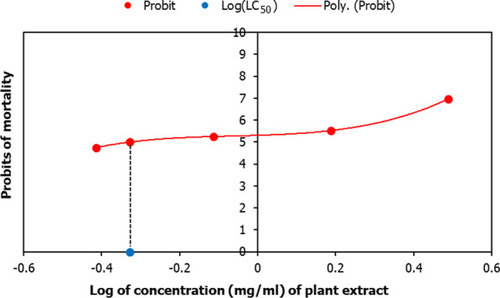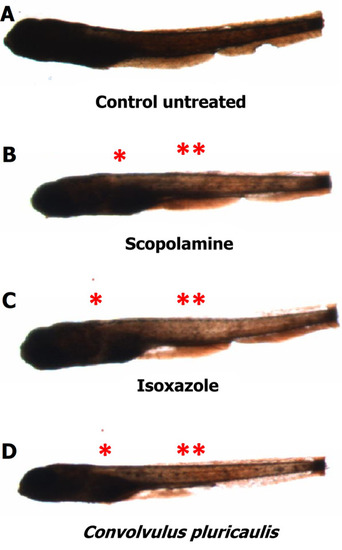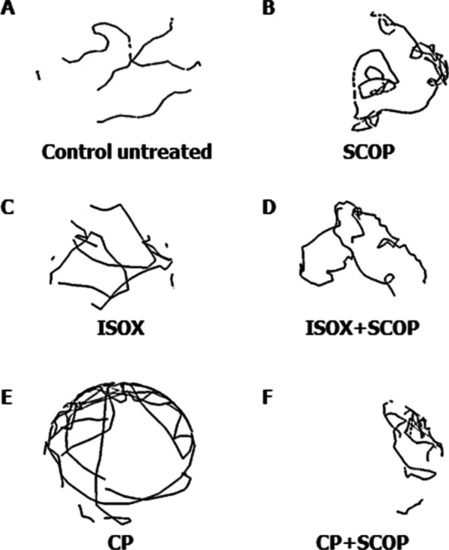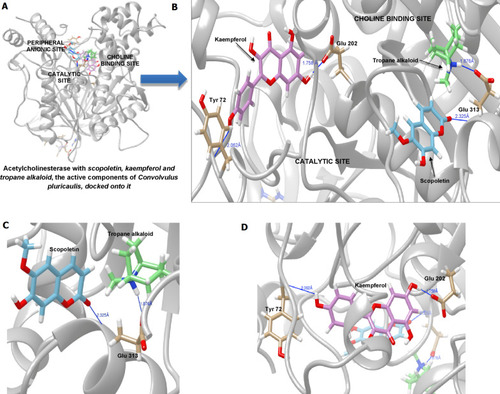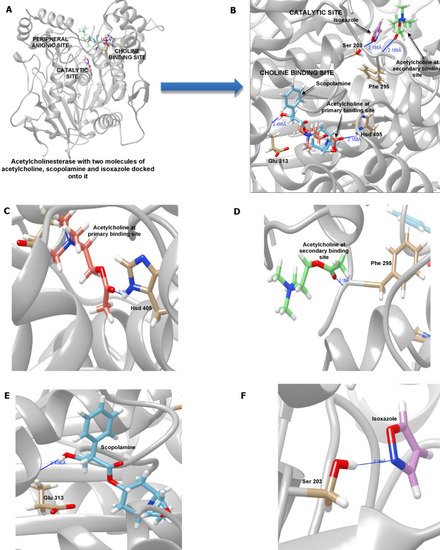- Title
-
Novel insights on acetylcholinesterase inhibition by Convolvulus pluricaulis, scopolamine and their combination in zebrafish
- Authors
- Karunakaran, K.B., Thiyagaraj, A., Santhakumar, K.
- Source
- Full text @ Nat Prod Bioprospect
|
Lethal concentration (LC50) of Convolvulus pluricaulis. The graph depicts the relationship between probit mortality and the concentration of Convolvulus pluricaulis (CP) (depicted as solid circles). The binomial response (death/no death) of 24 hpf embryos exposed to the plant extract was recorded over 48 h. The solid line represents the third-order polynomial equation that modeled the responses, i.e. y = 8.54x3 + 1.61x2 + 0.55x + 5.31, where y is 5.00 probits. LC50 of 0.4708 ± 0.089 mg/ml was obtained by calculating the inverse log value of x, and standard error as (log LC84 − log LC16)/√2N |
|
Effect of test compound(s) on acetylcholinesterase activity and acetylcholine levels. Acetylcholine (ACh) levels (blue bars), acetylcholinesterase (AChE) inhibitory activity (red bars), and acetylcholinesterase enzyme activity (green bars) in 168 hpf larvae unexposed to any test compound (i.e. ‘untreated’), treated with scopolamine (SCOP), isoxazole (ISOX), Convolvulus pluricaulis (CP) and their combinations (ISOX + SCOP, CP + SCOP, and CP + ISOX) have been shown. Both the ACh level (µM) and AChE activity (%) have been expressed as mean ± standard deviation. Three independent experiments were conducted to determine ACh level and AChE activity, and in each of these experiments, three sets of 15–25 embryos were treated with the least toxic concentrations of SCOP (6.68 μM), ISOX (1.04 mM), and CP (0.38 mg/ml) and their combinations. The larvae were treated with the AChE inhibitor (i.e. ISOX or CP) one hour before treatment with SCOP. *, **, and *** indicate p-value < 0.5, < 0.01 and < 0.001 of two-tailed unpaired t-test for untreated versus test groups respectively |
|
Localization of acetylcholinesterase activity in larvae treated with test compounds. The AChE activity in A untreated 168 hpf larvae and larvae treated with B scopolamine, C isoxazole, and D Convolvulus pluricaulis was visualized using Karnovsky–Roots staining. The intensity of the brown stain is indicative of the level of AChE activity. * indicates AChE inhibition in myelencephalon and ** indicates AChE inhibition in somites containing sensory interneurons and motor units |
|
Swimming patterns of larvae and adults in response to test compounds. The locomotion tracking plots (or ‘traces’) extracted from wrMTrck for A untreated, B scopolamine (SCOP)-treated, C isoxazole (ISOX)-treated, D ISOX + SCOP-treated, E Convolvulus pluricaulis (CP)-treated, and F CP + SCOP-treated larvae. The 168 hpf larvae were treated with the least toxic concentrations of SCOP (6.68 μM), ISOX (1.04 mM), and CP (0.38 mg/mL) and their combinations. Note that each larva is represented by a single trace. Three independent experiments were conducted with each of the treatment conditions to determine the locomotion patterns of the larvae. Three minutes long videos (2 min for acclimatization and 1 min for test response) of 3 larvae (per Petri dish placed on a light source) were shot in a dark chamber |
|
Effect of test compounds on the acquisition of avoidance response. Comparison of the crossing times of A control untreated and scopolamine (SCOP)-treated adults and B adults treated with isoxazole (ISOX) and Convolvulus pluricaulis (CP). The solid circles and squares represent the crossing times measured in the three training sessions and one test session, which was conducted 2 h after the training sessions. These crossing times have been expressed as mean ± standard deviation. Three independent experiments were conducted to determine the effects of SCOP, ISOX, and CP on the fishes, and in each of these experiments, at least 3–5 adult fishes were treated with the least toxic concentrations of SCOP (200 µM), ISOX (31.2 mM) and CP (11.4 mg/ml). The fishes were treated with the AChE inhibitor (i.e. ISOX or CP) one hour before treatment with SCOP. *, **, and *** indicate p-value < 0.5, < 0.01 and < 0.001 of two-tailed unpaired t-test for untreated versus test groups (in most cases, unless indicated otherwise) respectively |
|
Binding of Convolvulus active components to acetylcholinesterase. A, B Various pockets on acetylcholinesterase to which the active components, namely, scopoletin (and its central tropane alkaloid structure) and kaempferol, were bound, C Scopoletin and tropane alkaloid at Glu313, D Kaempferol binding at Tyr72 and Glu202 |
|
Binding of isoxazole and scopolamine to acetylcholinesterase. A, B Various pockets on acetylcholinesterase to which its substrate acetylcholine, isoxazole and scopolamine were bound, C Acetylcholine at Hsd405, the primary binding site, in the choline-binding pocket, D Acetylcholine at Phe295, the secondary binding site, near the catalytic site, E Scopolamine at Glu313 in the choline-binding pocket, F Isoxazole binding Ser203, a catalytic triad residue |
|
Concentration-dependent effect of CP + SCOP and ISOX + SCOP on acetylcholinesterase activity and acetylcholine levels. Acetylcholine (ACh) levels (blue bars), acetylcholinesterase (AChE) inhibitory activity (red bars), and acetylcholinesterase enzyme activity (green bars) in 168 hpf larvae unexposed to any test compound (i.e. ‘untreated’) and treated with the combinations of scopolamine (SCOP) with Convolvulus pluricaulis (CP) and isoxazole (ISOX), i.e. CP + SCOP and ISOX + SCOP, in varying concentrations have been shown. Two concentrations were tested for each of these combinations. For CP + SCOP, these were 0.19 mg/ml of CP + 3.34 μM of SCOP and 0.38 mg/mL of CP + 6.68 μM of SCOP. For ISOX + SCOP, these were 0.52 mM of ISOX + 3.34 μM of SCOP and 1.04 mM of ISOX + 6.68 μM of SCOP. Both the ACh level (µM) and AChE activity (%) have been expressed as mean ± standard deviation. Three independent experiments were conducted to determine ACh level and AChE activity, and in each of these experiments, three sets of 15–25 embryos were treated with the said concentrations. The larvae were treated with the AChE inhibitor (i.e. ISOX or CP) 1 h before treatment with SCOP. *, **, and *** indicate p-value < 0.5, < 0.01 and < 0.001 of two-tailed unpaired t-test for untreated versus test groups respectively |
|
Distance covered by the larvae treated by the test compounds. Histograms of the distances covered by untreated, scopolamine (SCOP)-treated, isoxazole (ISOX)-treated, Convolvulus pluricaulis (CP)-treated, ISOX + SCOP-treated, and CP + SCOP-treated larvae. Three independent experiments were conducted with each of the treatment conditions. *, **, and *** indicate p-value < 0.5, < 0.01 and < 0.001 of two-tailed unpaired t-test for untreated versus test groups (unless indicated otherwise) respectively |

